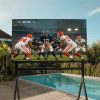My Ding a Ling
Have you been considering buying new speakers? Have you been looking at the monthly audio magazines to find a few prospects? Studying spec sheets and gathering information on the new materials being used in today’s speakers? In most popular price ranges there is a bewildering array of choices from literally hundreds of manufacturers. Click on one manufacturer’s web site and you can find 36 models of speakers that are sure to please you in one form or another. You have to wonder whether a speaker that has a frequency response from 36 – 20kHz actually sounds that much better, or even different, from a speaker that only covers 40 – 20kHz. Now that you’re on the internet, the choices have expanded exponentially. Suddenly there are hundreds more speaker manufacturing companies you have never seen advertised in the glossy magazines. Big ones, small ones, skinny ones and those with really odd shaped boxes. Or, no boxes at all. The more you look, the more confused the process becomes. So how do you begin to decide what speakers you want to listen to?
Pssssst, hey, buddy, ova’here
Alegria Audio is a small company out of the Washington State area that has some interesting designs based on single driver, full range designs. If you’ve never heard of a single driver, full range loudspeaker, you haven’t wandered far enough over to the left side of speaker design on the web. For every 1,000 conventional, play it safe, the marketing department likes these, 6.5″ two way bookshelf speakers for sale today, there may be one designer making a single driver design. For every 10,000 speakers for sale today, there may be one designer who considers frequency response of the speaker to be secondary to the emotional impact of the music. Of those designers who consider the music to be most important there will be a handful committed enough to be building a single driver, full range design. And, surprisingly, these designers are not living in their parents basement and do not have adhesive tape holding their eyeglasses together. A few might have a pocket protector shoved in a drawer somewhere. But, hey, pocket protectors got us to the moon. These are real speaker companies marketing a product you are unlikely to find in a hifi shop. And, it’s too bad they don’t get more exposure.
What’s it all mean?
While you were looking through the magazines, you might have seen an advertisement that showed a picture of the crossover network of a high priced, highly regarded (in the same magazines) speaker. Inductors, capacitors and resistors are lined up in order to provide the division of electrical energy between multiple woofers, midranges and tweeters. It is all very official looking and certainly seems like it should belong in an expensive speaker. Kind of the Ferrari V-12 of the speaker world. In this case, the speaker industry hopes what might hurt you, you don’t know about. All those parts, cables and circuit boards represent potentially lost signal energy. Energy converted to heat and literally gone up into the air before it ever reaches the speaker’s terminals. In a single driver, full range design there will be minimal, if any, parts to interfere with the energy of the music reaching the speaker itself. The driver is typically attached directly to the amplifier’s output terminals with nothing to distort or take away the music before it gets to your ears. Single driver designs apply the K.I.S.S. (keep it simple, stupid) method of straight forward design principles. When the capacitors, inductors and resistors are taken out of the signal path, more of the music’s energy that would otherwise be lost in the form of heat in the crossover can now get out into your room. This is the first benefit of a single driver, full range design. The music doesn’t sound like it is struggling to get out of the speaker box. Instead, the music is just in your listening room. There is an immediacy to the music and a feeling of the performer’s presence that is immediately evident; and even more so when you return to the typical commercial product. Nuances of performance and thought are portrayed easily and clearly with the best single driver designs. The music has a natural rhythm and flow that moves the music along and draws your attention to the musical performance and not to the speaker’s performance.
Without the extra parts which add electrical phase shifts and impedance swings to strangle the music, the single driver has a coherent, natural sound. It gives many of the benefits in sound quality of large, expensive, difficult to drive planar speakers with far fewer compromises in performance and domestic bliss. This certainly adds to the benefits of including a compact S.D.F.R. design in your home set up.























